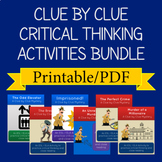Secret Santa Logic Puzzle: A Clue by Clue Critical Thinking Game
- PDF
Also included in
- This bundle contains all of my holiday clue by clue activities. These activities have students practicing critical thinking, logic, reasoning, and reading strategies as they solve a fun mystery or logic puzzle. They work for students of all ages and make a great group activity to get students talkinPrice $28.00Original Price $36.00Save $8.00
- By popular demand, all my clue by clue mysteries PDF (printable) format in one big bundle, plus a free mystery story organizing worksheet. Be sure to check the list above to see the exact list of Clue by Clue Mysteries!Each individual mystery is in PDF format and contains:A cover imageComprehensivePrice $90.00Original Price $123.00Save $33.00
Description
Enjoy this holiday-themed logic puzzle that gets students using critical thinking skills. Five friends have a Secret Santa party. Can your students follow the clues to figure out which gift everyone got and who their Secret Santa was? Perfect for practicing using process of elimination, evaluating evidence, deducing, and mathematical reasoning.
This logic puzzle makes a great warm-up activity, filler, or fast finishers activity. It can also be a fun holiday game. Or fit into a unit on critical thinking, inference skills, or mathematical reasoning.
This is a printable PDF to be used in class. Click here here for the GOOGLE FORMS edition of this mystery.
Inside find:
- Teacher Notes on how to use the resource, including suggested warm-ups and tips for doing a logic puzzle.
- A clear statement of the situation with all the names of the students and gifts. No gimmicks or hidden information here.
- 5 deceptively simple clues for students to ponder one at a time, to give them time to really think deeply.
- A puzzle-solving worksheet for them to track what they no and do not know along with an explanation of how to use it.
- Hints that walk through the solution step by step. These can be shared with students as needed.
- The Solution: Students are not left hanging. There's also a sample puzzle sheet so students can see how it should be filled out.
- Extension questions (optional) about companies with secret recipes.
Why Use Clue by Clues?
Clue by Clues encourage critical thinking and discussion. They are also close reading activities that teach students to look for details, synthesize information from different sources, apply prior knowledge about the world, and to recognize the logic of a claim and evaluate its validity.
While students are solving the mysteries, they are also developing their spoken language skills, using language such as:
- Modal verbs of speculation: She must have forgotten her keys, It could have been the butler
- Opinion language: I think...., I’m positive..., I’m not sure...
- Hedging: It’s possible, probably, maybe, it’s not impossible.
- Conclusions: That means that...
- Emphasis: There’s no way that...
- Hypotheticals: What if he didn’t do it, If he was at the movies, he couldn’t have done it.
They are also a lot of fun!
Enjoy this? Check out my entire Mystery Section and my other Christmas-themed activities!
And please leave a review. It helps others find this resource and gives me valuable feedback when creating new ones!







